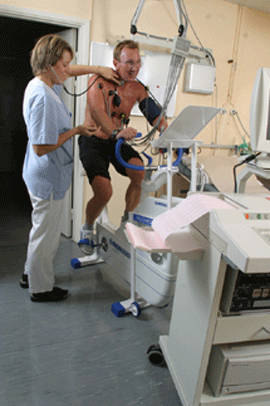
The data suggest that this CE test gives a reliable and valid estimate of VO2 max. Test-retest reliability coefficients for intensity (watts) on the maximal predictive CE test were 0.95 and 0.81 for males and females respectively (p less than 0.01). The VO2 max predicted from the Astrand-Rhyming test correlated significantly with VO2 max measured by CE and TM only in the male group. Correlation coefficients for VO2 max predicted from the maximal predictive CE test and VO2 max measured directly by CE and TM were 0.89 and 0.87 for males and 0.88 and 0.83 for females (p less than 0.01), respectively. When compared to TM VO2 max, VO2 measured during the final 30 s of the maximal predictive CE test was 16.0% and 16.2% lower for males and females respectively compared to VO2 max determined by the direct CE test, it was lower by 2.9% for males and 5.2% for females. This was compared with two direct measures of VO2 max and with the submaximal predictive test of Astrand-Rhyming. The highest work rate achieved was recorded as the endpoint of the test and used to construct regression equations to predict VO2 max. The test consisted of pedalling a cycle ergometer (Monark) at 75 rev X min-1, beginning at an intensity of 37.5 watts and increasing by this amount each min until the subject could no longer maintain pedal rate. A single work bout test with the resistance based on the individual's body weight provides a practical and accessible method to estimate CP and AWC.A maximal predictive cycle ergometer (CE) test for estimating maximal oxygen uptake (VO2 max) was evaluated in 15 male and 12 female subjects. The results of this study indicated that CP and AWC could be estimated from a single 3-minute work bout test on the Monark cycle ergometer with the resistance set at 4.5% of the body weight. The AWC values for the CP(PT) and CP(3min), however, were significantly greater than CP(3.5%) (8,357 ± 2,946 J). The mean CP(3min) (193 ± 54 W), however, was significantly greater than CP(PT) and CP(3.5%). The results indicated that there were no significant differences (p > 0.05) among mean CP values for CP(PT) (178 ± 47 W), CP(3.5%) (173 ± 40 W), and CP(4.5%) (186 ± 44 W). The resistance values for the CP(3.5%) and CP(4.5%) tests were set at 3.5 and 4.5% of the subject's body weight (kilograms).

time limit (T(lim)) relationship (CP(PT)) and a 3-minute all-out test (CP(3min)) against a fixed resistance and compared with the CP and AWC estimated from the new 3-minute tests on the Monark cycle ergometer (CP(3.5%) and CP(4.5%)). pre-test: Explain the test procedures to the subject. equipment required: Fleisch or a modified Monark cycle ergometer. The CP and AWC were estimated from the original work limit (W(lim)) vs. purpose: the aim of this test is to measure the anaerobic power of the lower body. Twelve moderately trained adults (mean age ± SD = 23.2 ± 3.5 years) performed an incremental cycle ergometer test to exhaustion. The purpose of this study was to develop a 3-minute, all-out test protocol using the Monark cycle ergometer for estimating the critical power (CP) and anaerobic work capacity (AWC) with the resistance based on body weight.


 0 kommentar(er)
0 kommentar(er)
